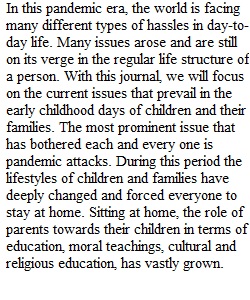


Q Instruction for Weekly Course Readings/Discussion Journal assignments Overview There are 30-50 pages of required reading each week. You should either purchase/rent the textbooks or use the copies that are on reserve in the library. All of the supplemental readings can be found on Canvas. Then you will prepare a 2-4 page reading reflection/summary of the readings and application to current issues on young children and families. Your response will require you to utilize your best thinking and writing and your grade will be determined by how thoughtfully and completely you respond to the questions posed. Please make sure that you are responding to all components of the prompt. 20 points x 7 rounds = 140 points max (14%) There are six learning objectives that accompany this assignment. 1. Develop awareness of educational equity and social justice issues to advocate for early childhood best practices and to exhibit professionalism in the field of ECS. 2. Demonstrate an understanding of the relationship between children, their families, and communities with special emphasis on socio-economic, linguistic, gender, and ethnic differences. (SLO/NAEYC standards 1,2,3) 3. Analyze and critique classic and contemporary theories and research that examines child development and learning (SLO/NAEYC standards 1,2,3) 4. Apply and integrate different theories and current research findings of child development and learning to analyze practices used in the family, home and community in the context of diverse settings (SLO/NAEYC standard 4) 5. Apply knowledge of linguistically and culturally appropriate strategies to support all children including children from diverse backgrounds, DLLs and children with special needs (SLO/NAEYC standard 2) 8. Demonstrate intellectual rigor in all course assignments, utilizing the ECS Framework for Critical Reflection Step by step instructions Step 1: Read the reading assignment(s) carefully. Use a pen/notebook or computer to take a reading note as you read. I would think that you may need more than 45 minutes to finish each reading assignment, and I anticipate that some materials may require you to read multiple times to really understand the content. Please regard that as a great opportunity to engage in an important dialogue with the authors and the thinkers, instead of being discouraged :) Step 2: Review your reading notes and the material(s). Then use it to ask yourself these questions; • Q1. What are the main concepts/ideas being discussed here? Am I able to summarize it in my own words? • Q2. What sorts of evidence or explanations are presented here to support these ideas/concepts? • Q3. Are multiple points of view and/or different explanations presented here? If so, what are they? And how are they related or different from each other? • Q4. What implications does the material have for current issues on young children and families? How does this material help me think about what is happening to young children and their families currently? Step 3: Write up a 2-4 page essay, and upload it to Canvas before class (usually, by 4pm, Mondays) Your essay needs to include; • Summary of the reading(s) (Q1) • Your discussion/Analysis on the main concepts/ideas (Q2 and Q3) • Implications/applications to what is happening to young children and families currently (Q4) Step 4: Once you submit your assignment, Canvas automatically assigns you to do a peer review for one of your classmates. Canvas automatically gives one of your classmates’ submissions to you by Tuesday, 4 pm. Read your classmate’s essay, then provide feedback by the following Monday, 4 pm. Rubric • Element 1: Critical thinking o Considers multiple points of view and/or different explanations (X say____, whereas Y say ____). o Includes original analysis, synthesis, and evaluation of key ideas o Analysis, synthesis, and evaluation is supported by sound reasoning and reliable evidence (facts, data) o Questions generalized statements and values o Considers pros and cons o Considers practical and ethical implications • Element 2: Professional Writing o Is your grammar, syntax, and punctuation used correctly so that the reader does not need to re-read the sentence? o Did you explain concepts well? o Did you give an example to explain concepts? o Writing is organized (for instance, the use of effective and accurate use of organization tools, such as headings and subheadings) o Uses precise academic citations in APA styles (See this website for APA format). o Uses effective word choice and clear phrasing o Do your ideas make sense together? • Element 3: Fulfillment of criteria o Meets word count expectations (2 page minimum) o Makes at minimum one clear link to a key theory/idea/concept in the course o Produce writing that meets the ECS Standards for Critical and Thoughtful Writing (Links to an external site.) o Demonstrate intellectual rigor in all course assignments, utilizing the ECS Framework for Critical Reflection o Correctly uses at minimum two vocabulary terms from the related session and defines them in the student’s own words (or provides textbook definition with a proper citation and a student example that demonstrates understanding) o Makes at least one connection to the session’s reading(s) with the appropriate APA citation o Answers all the questions in the prompt o Includes all relevant information
View Related Questions